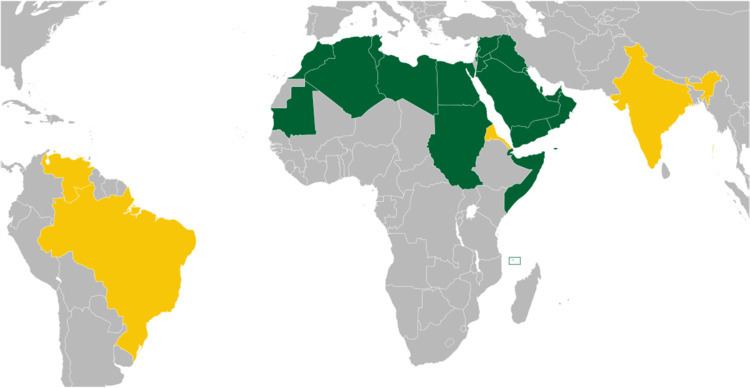Continent Asia and Africa Highest point Jbel Toubkal
4,165 m Longest river Nile
6,853 km | Area Ranked 2nd Lowest point Lac Assal
−155 m | |
 | ||
The Arab League is a regional organization of Arab states in Western Asia, North Africa, the Horn of Africa and the Indian Ocean. It covers a combined area of 13 million km². The League extends from Morocco in the west, southward to the Comoros, eastward to Somalia, and northward to Iraq.
Contents
Geography of each state
The Arab League has 22 member states. See the geography of each state:
Regions
The Arab League has a high population density, with an estimated 350 million inhabitants. Geographical terrains in the area can be divided into three: the large arid desert covering most of it, the fertile south and north, and finally the high mountains of the Atlas, Ahaggar, Zagros and the Anti-Lebanon mountains, along with the Hijaz Mountain range.
The Arab League can also be divided into two main geographical regions: an Asian part, which has 12 states, and a larger African part, which has 10 states. Adjacent to the League are 14 land neighbors and 4 sea neighbors.
Culturally, the Arab states can be divided into 6 regions:
Geographically, the Arab League member states are further subdivided into four regions:
Landscape
Most of the Arab League falls in the driest region of the world. Almost 80% of the Arab world is covered in desert (10,666,637 of 13,333,296 km2), stretching from Mauritania and Morocco to Oman and the UAE. The second most common terrain is the semi-arid terrain, which found in all Arab countries except Lebanon and Comoros.
Several deserts span the Arab League:
The highest point in the Arab League is in Morocco called Jbel Toubkal, standing 4,165m tall, making it the 40th highest place on earth, and 6th in Africa, next comes Jabal an Nabi Shu'ayb (at 3,666 m) in Yemen and Cheekha Dar (at 3,611 m) in Iraq.
The lowest point in the Arab League is the Dead sea between Jordan and Palestine. At 1,312 feet (400 meters) below sea level it is also the lowest point on Earth.
Climate
The hottest temperature recorded in the Arab League took place in Sudan on June 25, 2010, reaching 49.6 °C (121.3 °F) in Dongola, breaking a record set in 1987.
